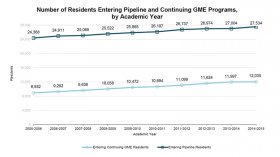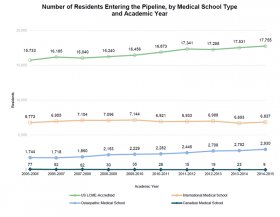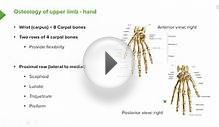
 The Accreditation Council for Graduate Medical Education (ACGME) recently published its annual (DRB). The ACGME DRB provides authoritative data on trends of interest to those involved in Graduate Medical Education (GME) and physician workforce policies.
The Accreditation Council for Graduate Medical Education (ACGME) recently published its annual (DRB). The ACGME DRB provides authoritative data on trends of interest to those involved in Graduate Medical Education (GME) and physician workforce policies.
The new Book documents a small but steady growth in “pipeline” programs—which lead to initial board certification—and a larger percentage growth in the number of “continuing” programs and positions in subspecialties. It also documents that a large number of foreign medical school graduates continue to enter GME each year.
Data On GME Trends
The ACGME is the accrediting body for US allopathic training, and all ACGME-accredited programs report basic data to the organization. The ACGME DRB summarizes data for the previous academic year (2014-2015 in this case) and trends for the last 10 years. The Book includes data on the residents and fellows entering and completing training, as well as geographic and other characteristics of GME programs, leadership, and faculty as reported for accreditation purposes. The strength of the data is its completeness and the consistency of the data collection process.
The ACGME reports 27, 534 entrants into pipeline programs for 2014-15. This includes 2, 930 doctors of osteopathic medicine (DOs) who entered ACGME-accredited programs during the academic year. However, as of 2014-15, residency programs approved solely by the American Osteopathic Association (AOA) were not accredited by the ACGME, and therefore the programs and their residents are not included in the Book. Since there were about 2, 000 entrants into residency programs authorized solely by the AOA in 2014-15, the ACGME data is missing roughly 7 percent of those entering GME.
 Osteopathic residents and fellows in ACGME-accredited programs are increasing in number and totaled 10, 999 in 2014-15. The good news is that a merger of the ACGME and AOA accreditation systems is underway, so within the next few years a single comprehensive source of data on all GME should be available.
Osteopathic residents and fellows in ACGME-accredited programs are increasing in number and totaled 10, 999 in 2014-15. The good news is that a merger of the ACGME and AOA accreditation systems is underway, so within the next few years a single comprehensive source of data on all GME should be available.
While many people use the data from the National Resident Matching Program (NRMP) to monitor the inflow of physicians into training, not all physicians go through the match, so caution is needed in interpreting the NRMP data. The advantage of the NRMP data is that it is available several months before the training year begins and about 18 months before the ACGME data.
While NRMP data is not as complete as ACGME data, it is getting more complete. Until recently, only US MD seniors were required to go through the NRMP. Each year, several thousand physicians, predominantly international medical school graduates (IMGs), went outside the NRMP and directly secured positions in residency programs.
With the recent introduction of the “all in” NRMP policy, programs cannot recruit residents both through and outside the NRMP. Almost all residency programs are now participating through the NRMP. However, the NRMP data does not encompass the matches for AOA-accredited programs, the military matches, or the San Francisco match (which includes ophthalmology and several sub-specialties). At this time, we do not know how many residency positions are obtained outside of the NRMP.
RELATED VIDEO












